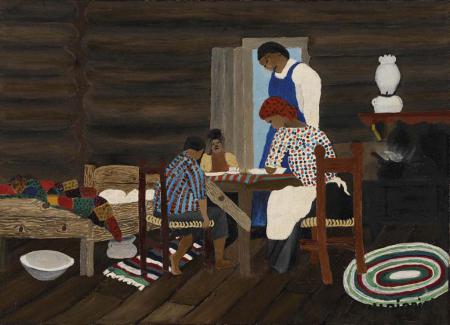Serendip is an independent site partnering with faculty at multiple colleges and universities around the world. Happy exploring!
About Giving Thanks

Giving Thanks
That is a small sized picture compared to all the other works hung up on the wall. After walking around the museum several times, it attracted my attention. It’s a portrait of a small wooden house (or room). With one single bed on the left, a table in the middle and several people around, it’s a normal scene. But it has some attractions distinguished from the rest of the museum.
The use of colors is the first thing that captured my eyes: the mainstream is black, dark red, brown and white, repeatedly. But even with these mainly dark colors, my impression for it is still bright. The whiteness is conspicuous---it has a strong sense of presence. The painting is incompatible with the other ones on the same wall, the contrast of color brought up a brand-new feel, and even it’s an old art piece talking about time few decades ago. The whiteness draws clear outlines in this painting: the pillows, the plates, the apron of the woman, and in the texture of the carpet. However, the whiteness did not have a delightful feeling; it’s just neat, or even dazzling. The only color I like is the sky outside their door: pure blue, without even a piece of cloud or a glance of horizon. I wondered that this might be the painter’s expression of life: the pure beauty outside be the dream and the inside darkness is the reality. The sky is also the light source of the room because there’s no lights inside the room.
The other thing that I like about this painting is the layering. Every character is painted on the canvas after the wood house, so the figure stands on the background instead of merge in it. I can track the order of the painting: first the brown wooden house, painted in an abstract brush dyed with white to show the texture, then the bed, the table, the decorations and people. The clear layering highlighted the characters.
According to the audio tour, this painting is the reflection of working-class black people. And that led my thought to reform a story: after days of exhausting works, the family members finally had a chance to have dinner together. Refer to the name of the painting: giving thanks, the time might be a thanksgiving day, a day with turkey and apple pie. But they only have two white plates and a cup on their table, which might be caused by their poverty---- the details showed that they’re not rich: this small room not only serves as a bedroom, but also a dining room, or maybe a kitchen (it has a pot on the cabinet.) The room decoration is also simple: there’s only a bust on the shelf. There’s no one to take care of the house as everyone works in the family, they all have a tired look. Their faces formed no smiles, only numbness, or sorrow. Is that because they have a bad holiday while every other family gathering in their warm house having luxurious dinner? Or are they having a moment of silence after a family fight? The standing man looked down on the desk, the boy is staring at the floor, the mother with a head kerchief bowed her head, and the old woman, might be a grandma, is looking at the point of the painter---- There’s no eye contact in the family. They are not harmonious during this family time. In the other lens, I saw a glance of the society for working-class: endless, dull, with no color in life.
I came to this painting with no knowledge of art: I cannot recognize which kind of art it is, the tools he used in drawing, or the painting skill he had but it formed a whole picture for me: an integrated picture of a family with every detail.
When I tried to observe the painting, so many things just come up to me. It reminds me of the time in 5th grade, when the art teacher had the new book handed to everyone. I stared at the cover---Guernica (by Picasso) for the whole class. That time I felt an unprecedented feeling; I had tears in my eyes and could not hear any voice from outside. I have thought that the inspiration of art cannot be expressed by words, all the analysis, to me, seems worthless. But when I started writing this paper, I wanted to share my observation with the readers, and express what I saw in the painting. Art is a form of expression, and could be seen differently from everyone. In this experience with giving thanks, I have seen many hidden meanings of this art piece. It speaks to me, and showed me the painter’s lens. (Anyway we’ve been talking about lens for more than half of this class, and now I finally got to experience seeing from another lens an author formed for me.)
I appreciate the piece.



